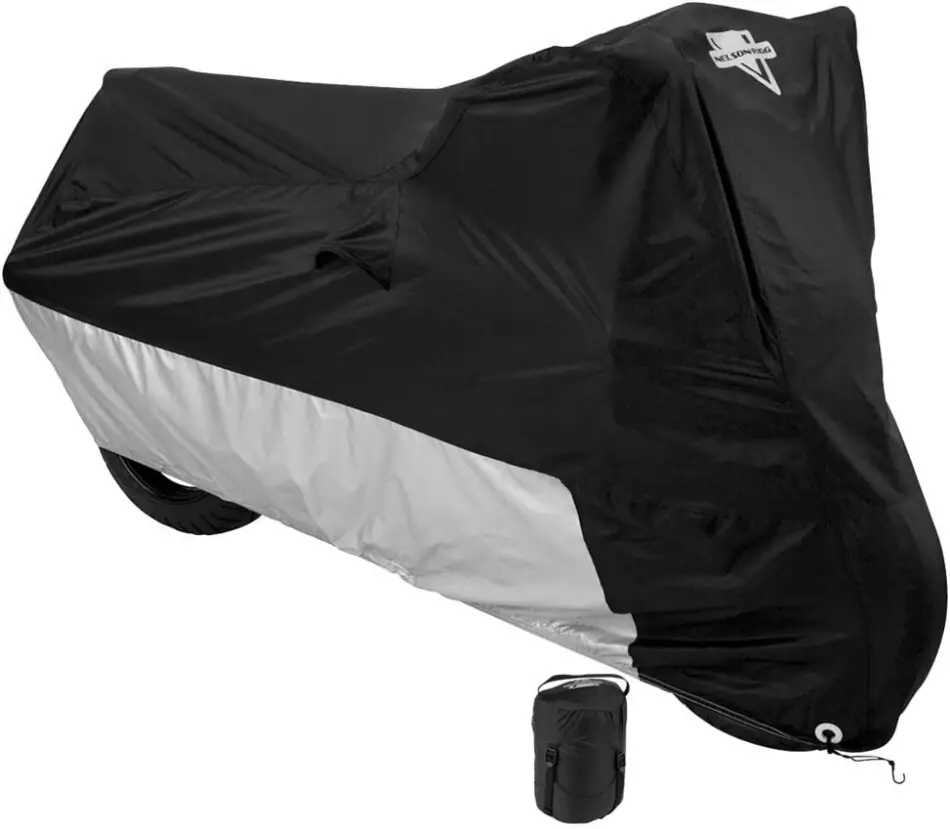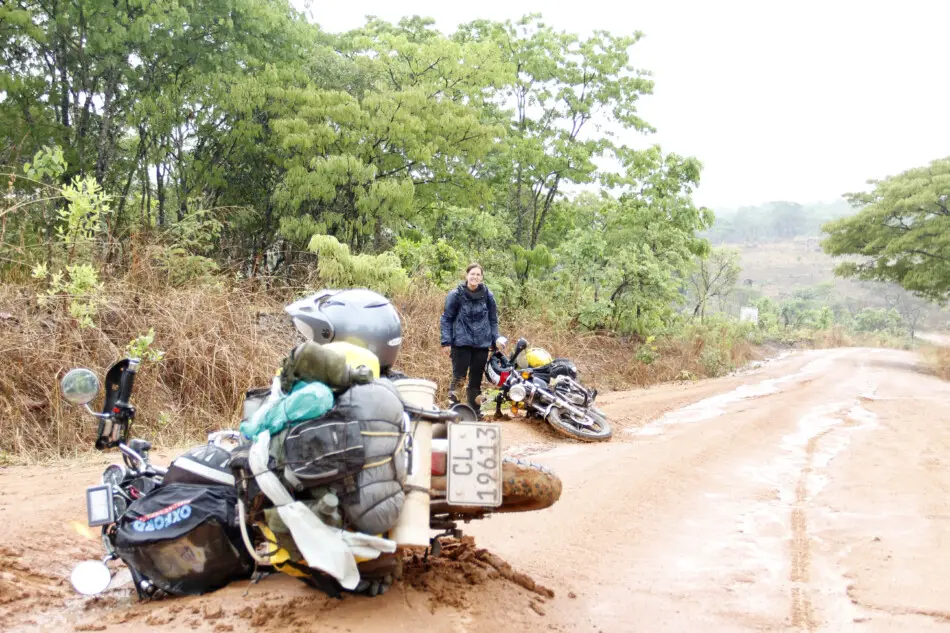Not everyone is fortunate enough to have a garage to store their motorcycle. I don’t. This means that many riders have to store their bike outside, exposed to the elements. The big question is, can I leave my motorcycle in the rain for extended periods of time without causing lasting damage?
Leaving your motorcycle out in the rain will not necessarily cause damage, provided that you clean, dry, and lubricate the vulnerable parts. Extended exposure to rain can cause your motorcycle to rust, especially the chain, sprockets and brake discs. Damage to your motorcycle is usually caused by neglect, rather than exposure to rain.
Since my bike sleeps outside, I asked around and read opinions from many different riders on different forums, and this is what I’ve found.
Is Standing in the Rain Bad for my Motorcycle?
Motorcycles are designed to withstand getting wet, otherwise you’d never be able to ride when it is raining. The air intake is shielded by a cover so that water cannot enter the carburetor or intake manifold. Electrical plugs are concealed by the gas tank or seat, and where exposed, are waterproof. In short, your bike won’t stop running due to rain.
Many riders use their bikes to commute and are bound to get caught in a rain storm at some point. If you tour on a motorcycle for long periods of time, riding through rain is almost inevitable. On our 3-month long Cape to Cairo trip, my wife and I rode in the rain for nearly 10 days straight.
NOTE: Rider safety in the rain is a bigger concern than damage to your motorcycle. Check out my post on ‘How to safely ride in a motorcycle in the rain’
Francois
If motorcycles are designed to ride in the rain, how bad can it be when you let is stand in the rain for longer periods of time?
Is it Bad for a Motorcycle to Stand in the Rain for Extended Periods of Time?
If your bike is parked in the rain for days on end, at some point the exposed metal will start to rust. Especially where the painted surface (of the frame or tank) has been scuffed or scratched. Other components that will rust after spending a lot of time in the rain are your motorcycle’s chain and sprockets, the top portions of your front forks, brake discs, and any fasteners.
Water also has a tendency to get into any little nook and cranny. If you ride often, the wind will dry out most of the water that has collected on the bike. If, on the other hand, you leave the bike standing for months, these wet spots will start to corrode.
Some motorcycles will definitely start to show signs of rust sooner than others. Older bikes with lots of scratches to the frame and paintwork will start to rust at the damaged areas. Cheaper Chinese motorcycles will also rust sooner, especially the lower grade steel nuts and bolts.
If you live close to the coast or in areas where the roads are salty, rust may become a much bigger problem. High humidity is another factor to consider. A bike that is stored in a garage with high humidity can start to rust even though it is kept inside.
Your bike’s paint work should be okay if you regularly dry it after a rain storm and keep it waxed or polished. The sun’s UV rays are of bigger concern. Long term exposure to direct sunlight will cause paint and plastics to fade, rubber hoses to become brittle, and the seat material to tear and disintegrate.

Apart from cosmetic damage and corrosion of the drive train and brakes, water can seep into the switchgear on the handlebars. You won’t notice this right away, but over time the mechanisms inside can corrode which may cause intermitted (read ‘very frustrating!’) electrical problems. This is because rust on the connections do not conduct electricity, thereby braking the circuit.
If the kill switch gets dirty the bike may not start. The lights, indicators and horn may start acting up if the switches get dirty inside.
In some cases, water could even enter the carburetor float bowl and cause your bike to stall when you give it gas. Ask me how I know! My old Yamaha XT 500 did this every time it stood in the rain for a couple of days. If your bike dies when you give it gas, there could be other causes as well. Check out this post to find out more.
While a bike would definitely be better off parked in a dry garage away from the elements, standing in the rain won’t necessarily harm the bike. Water damage generally occurs due to poor maintenance and neglect, rather than rain per se.
How to Protect Your Motorcycle Against the Rain
The best way to protect your motorcycle against water damage from standing in the rain is by parking it inside a garage (or your living room?!) or at least under a carport. Many riders do not have access to under-cover parking. In that case, a good quality motorcycle cover is your best bet.
For the best protection against direct sunlight and moisture that can cause rust, get a motorcycle cover that can breathe. This will allow moisture to evaporate and not build up under the cover. A cheap tarpaulin is a bad idea. Trapped moisture may cause rust and mildew, which may be worse than just leaving your bike out in the open.
You don’t have to break the bank to buy a good quality motorcycle cover that will protect your bike from the elements. A cover like the one below from Nelson-Rigg will offer good protection at a reasonable price on Amazon.

If you do place a bike cover over your bike, make sure it is properly tethered to the bike so that it won’t blow away in the wind. Also, take care if the wind is very strong, as a bike cover could act like a sail and cause the wind to blow over your bike.
If the weather permits, ride your bike often. This will allow water and trapped moisture to blow (and shake) dry. The heat of the engine will also allow damp areas to dry out. After every ride, make sure to hose down any mud, salt, and dirt before drying the larger areas.
Don’t let water on the gas tank, windscreen, fairings, saddle, or headlights dry by itself. Depending on the conditions, droplets may cause permanent stains that is hard to remove. By drying your motorcycle with an absorbent chamois (like this cheap one off Amazon), your bike’s finish will look good for much longer.
After every ride in the rain, or once a week if your bike is parked out in the elements, clean your chain and properly lubricate the chain and sprockets (like this). Apply some grease to all the exposed nuts and bolts to prevent corrosion and spray WD-40 inside the switchgear to dispel any moisture. It is also a good idea to apply some dielectric grease inside any exposed electrical connectors.

If surface rust starts to appear (common places are the top of the fork legs and on shiny rims and exhaust pipes), take some Scotch-Brite pads and WD-40 to rub out the rust. Then apply a thin film of WD-40 to prevent any rust from reappearing.
If you have no choice but to park your motorcycle out in the rain (like I do), make sure you regularly clean and lubricate your motorcycle. If you do, there’s no reason why your bike has to rust and corrode in the rain.
Is it Okay to Ride Your Motorcycle in the Rain?
It is perfectly fine to ride your motorcycle in the rain. In fact, motorcycle manufacturers design their bikes with that in mind. It is inevitable that you’ll get caught out in the rain at some point while riding your motorcycle.
Your personal safety is of far greater concern when you ride your motorcycle in the rain or on wet and slippery roads. Regardless of whether you ever plan on riding in the rain or not, please read this post on ‘How to Safely Ride a Motorcycle in the Rain‘.
I’ve ridden in pouring rain for days on end, on wet tarmac and muddy dirt tracks. As long as you take it easy, wear the appropriate gear, and properly maintain your motorcycle, you will be fine.

The mental aspect is as much a concern as the physical. I remember Ewan McGregor saying (in Long Way Round) that you should just keep the rain out of your head. It’s totally true! It is just water.
The more you relax and accept that your underpants are going to get soaked, the safer you’ll be.
After a ride in the rain, make sure to hose down your bike to get rid of any dirt, mud, and salt. Dry the surface areas with a chamois or towel, and lube the exposed metal parts (at least the chain). Your bike with thank you!
Conclusion
While it is not ideal, your motorcycle won’t get seriously damaged just by standing in the rain. Obviously, extended periods (months, not days) of exposure to the elements will cause some components to deteriorate faster than in a dry garage. As long as you properly clean and maintain your bike, standing in the rain should not be an issue.
To sum it up, neglecting a motorcycle that is parked in a garage is worse than looking after one that sleeps outside in the rain.
